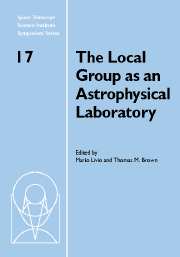 The Local Group as an Astrophysical Laboratory
The Local Group as an Astrophysical Laboratory Published online by Cambridge University Press: 12 May 2010
The feedback effects of massive stars on their galactic and intergalactic environments can dominate evolutionary processes in galaxies and affect cosmic structure in the Universe. Only the Local Group offers the spatial resolution to quantitatively study feedback processes on a variety of scales. Lyman continuum radiation from hot, luminous stars ionizes H II regions and is believed to dominate production of the warm component of the interstellar medium (ISM). Some of this radiation apparently escapes from galaxies into the intergalactic environment. Supernovae and strong stellar winds generate shell structures such as supernova remnants, stellar wind bubbles, and superbubbles around OB associations. Hot (106 K) gas is generated within these shells, and is believed to be the origin of the hot component of the ISM. Superbubble activity thus is likely to dominate the ISM structure, kinematics, and phase balance in starforming galaxies. Galactic superwinds in starburst galaxies enable the escape of mass, ionizing radiation, and heavy elements. Although many important issues remain to be resolved, there is little doubt that feedback processes plays a fundamental role in energy cycles on scales ranging from individual stars to cosmic structure. This contribution reviews studies of radiative and mechanical feedback in the Local Group.
Introduction
The Local Group is especially suited as a laboratory for studying the effects of the massive star population on the galactic environment. There are three types of massive star feedback:
(a) Radiative feedback, i.e., ionizing emission, which results in photoionized nebulae and diffuse, warm (104 K) ionized gas;
(b) Mechanical feedback, predominantly from supernovae (SNe), resulting in supernova remnants (SNRs), superbubbles, and galactic superwinds; and
[…]
To save this book to your Kindle, first ensure no-reply@cambridge.org is added to your Approved Personal Document E-mail List under your Personal Document Settings on the Manage Your Content and Devices page of your Amazon account. Then enter the ‘name’ part of your Kindle email address below. Find out more about saving to your Kindle.
Note you can select to save to either the @free.kindle.com or @kindle.com variations. ‘@free.kindle.com’ emails are free but can only be saved to your device when it is connected to wi-fi. ‘@kindle.com’ emails can be delivered even when you are not connected to wi-fi, but note that service fees apply.
Find out more about the Kindle Personal Document Service.
To save content items to your account, please confirm that you agree to abide by our usage policies. If this is the first time you use this feature, you will be asked to authorise Cambridge Core to connect with your account. Find out more about saving content to Dropbox.
To save content items to your account, please confirm that you agree to abide by our usage policies. If this is the first time you use this feature, you will be asked to authorise Cambridge Core to connect with your account. Find out more about saving content to Google Drive.